 This is the Voskhod (Восход), a 35mm scale focus camera built by Leningradskoye Optiko-Mekhanicheskoye Obyedinenie (LOMO for short) between the years 1964 and 1968. The Voskhod was a well built and uniquely designed camera with an arrangement of controls that made it ideal for both landscape and portrait orientation. It included a coupled selenium exposure meter with an analog needle in the viewfinder showing whether the camera’s settings would make a correct exposure. Although lacking any sort of focus aide, the large depth of field by the camera’s 45mm triplet meant that zone focusing was very easy. The camera’s unique look and clever ergonomics proved to many that the Soviet Union was capable of making more than just cheap Leica knockoffs.
This is the Voskhod (Восход), a 35mm scale focus camera built by Leningradskoye Optiko-Mekhanicheskoye Obyedinenie (LOMO for short) between the years 1964 and 1968. The Voskhod was a well built and uniquely designed camera with an arrangement of controls that made it ideal for both landscape and portrait orientation. It included a coupled selenium exposure meter with an analog needle in the viewfinder showing whether the camera’s settings would make a correct exposure. Although lacking any sort of focus aide, the large depth of field by the camera’s 45mm triplet meant that zone focusing was very easy. The camera’s unique look and clever ergonomics proved to many that the Soviet Union was capable of making more than just cheap Leica knockoffs.
Film Type: 135 (35mm)
Lens: 45mm f/2.8 LOMO T-43 coated 3-elements
Focus: 0.9 meters to Infinity
Viewfinder: Scale Focus with 45mm Projected Frame Lines
Shutter: Behind the Lens Leaf
Speeds: B, 1 – 1/250 seconds
Exposure Meter: Coupled Selenium Cell w/ viewfinder match needle
Battery: None
Flash Mount: Cold shoe and M and X Flash Sync
Weight: 693 grams
Manual: https://mikeeckman.com/media/VoskhodManual.pdf
How these ratings work |
The Voskhod is one of the most distinct looking cameras ever made. With a body that was designed to be used both vertically and horizontally, the Voskhod feels most natural in portrait orientation. Although featuring a parts bin Smena lens, the shutter has a useful range of 1-1/250 speeds, a really well designed film advance system, a coupled exposure meter, and a large and bright viewfinder. When found in working condition, the Voskhod is a strange, but fun camera to use and it’s T-48 triplet lens produces excellent results. | ||||||
| Images | Handling | Features | Viewfinder | Feel & Beauty | History | Age | |
| 2 | 2 | 1 | 2 | 2 | 1 | 20% | |
| Bonus | none | ||||||
| Final Score | 12.0 | ||||||
History

The entirety of the Soviet camera industry was a very complex operation, with factories producing a great number of cameras, lenses, and other photographic products all over the country. The Arsenal factory in Kyiv, Ukraine made Kiev rangefinders and Salyut SLRs, FED rangefinders were made in Kharkov, Ukraine, and in the KMZ factory in Moscow a great number of cameras like the Zenit and Start SLRs, Zorki and Droug rangefinders, plus a great number of other models were produced.
While many cameras from Arsenal, FED, and KMZ are well known with collectors today, the one factory which produced the most different models was the GOMZ/LOMO factory in Leningrad, now St. Petersburg, Russia.
GOMZ was short for Gosudarstvenniy Optiko-Mekhanicheskii Zavod which translates to State Optical-Mechanical Factory. Established in 1914, it transitioned to optical production in 1930 as one of the first Soviet factories to produce cameras and lenses. One of it’s first products was the folding Fotokor-1, which was an inexpensive copy of a German 9×12 folding camera, but in the years that would come, GOMZ would produce a dizzying array of models. Most GOMZ cameras were of the inexpensive variety which allowed them great success at introducing photography to the masses in the Soviet Union.

In 1939, GOMZ would release a camera with an all Bakelite body and a front “scissors” folding design called the Smena (Смена) which strongly resembled the Kodak Bantam. Designed by Ilya Grigoryevich Shapiro who was responsible for several other cameras including the later GOMZ Leningrad, the original Smena (which loosely translates to ‘change’ or ‘shift’) featured several improvements over the Bantam including a more versatile shutter, a focusing lens element, and a different viewfinder. Despite being a novel little camera, the original Smena was not in production long, likely due to Russia’s involvement in the war.
The GOMZ factory’s location in Leningrad spared it from destruction during the war, so once it had ended, GOMZ was one of the first Soviet factories to resume producing cameras and optical products.
In 1953, Ilya Grigoryevich Shapiro would once again release an inexpensive Bakelite 35mm camera using the name Smena, but this time, it was an all new design. Why was the name “Smena” used once again for an entirely different camera? On his site sovietcams.com, author Aidas Pikiotas hypothesizes that the release of the new Smena coincides with the death of Joseph Stalin and could have been seen as a “Change” in leadership, or it could have just been a coincidence. Whether any of that is true or not, is anyone’s guess and we’ll likely never know.
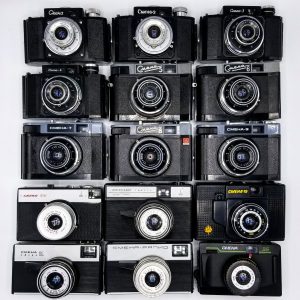
The Smena series would be one of the most popular and affordable of all Soviet cameras. Produced both for domestic use and export, there are over 25 different models in the Smena family, the last of which were produced until after the fall of the Soviet Union.
In 1962, the GOMZ factory would be reorganized as Leningradskoye Optiko-Mekhanicheskoye Obyedinenie, or LOMO for short, which is the name it still uses today. Many cameras in production from around this time exist with GOMZ, LOOMP, and LOMO markings, the LOOMP ones being the least common.
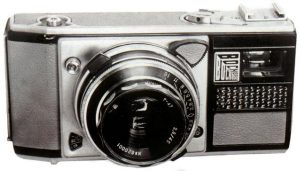
In 1964 a prototype for a new camera was created called the Восход or Voskhod, which loosely translates to “sunrise” in English. The Voskod had a design unlike any other camera ever made, Soviet or otherwise. Featuring an elongated rectangular body, and locations for the viewfinder, shutter release, and focus scale that meant the camera was just as comfortable to be used in both landscape and portrait orientations. This dual purpose design was intentional as was the design of the Восход logo on the front of the camera which is written in a way that is readable while holding the camera in either direction.
Although featuring a simple 3-element T-48 lens and a fixed leaf shutter that topped out at 1/250 seconds, the Voskhod had an all aluminum body and an unusually high build quality, especially when compared to other GOMZ produced cameras like the Smena which were mostly made of plastic.
According to Alfred Klomp’s excellent resource on the Voskhod, it is not clear exactly who the target audience the Voskhod was designed for. It would have been too expensive to sell in great quantities to domestic photographers, and it’s odd shape and ergonomics would have made it difficult to sell to an export market who by the time of the camera’s release would have preferred more traditional rangefinder and single lens reflex models, than a strange looking scale focus camera made in Russia.
The Voskhod was in production from 1965 to 1969, with just under 60,000 units made. Although no major changes were made to the camera throughout it’s production line, minor cosmetic variations exist with screws located in different parts of the body, some with MX flash sync levers, and some without, and finally exported versions replacing the Cyrillic logo with and English “Voskhod” logo and “Made in USSR” markings.
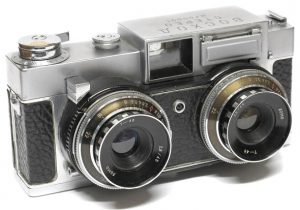
A very rare Voskhod Stereo prototype was created that apart from sharing the name and both the T-48 lens and shutter from the original Voskhod, looks to me like an entirely different camera.
The presence of an English language manual and export versions without Cyrillic names suggests the camera was sold in English speaking countries, but in my research for this article, I found no evidence of the camera being sold in the United States. I found no advertisements, articles, or reviews, suggesting that if it was sold here, it was done in very low numbers. Researching the Voskhod had an additional challenge as there was also a Soviet space mission, rocket, and capsule called Voskhod , Voskhod motorcycles, and a brand of razor blades called Voskhod that come up often in search results.
Today, the Voskhod is relatively unknown outside of Soviet camera collector circles, but remains a popular model as it’s distinct looks, above average build quality and unique operation make it a favorite to display and shoot. The camera is very difficult to find in the US, so acquiring one here usually means importing one from overseas, but for those who have an opportunity to pick one up, should find it to be an excellent addition to their collection.
My Thoughts
My first experience with Soviet cameras were FED, Zorki, and Kiev rangefinders, all of which are very close copies of German cameras that came before them. Then came the Zenits and cameras like the Leningrad and KMZ Start, all three cameras which are unique to the Soviet camera industry, but not exactly direct copies of anything.
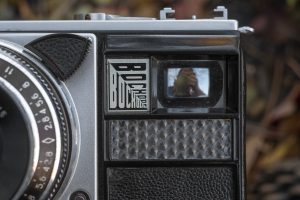
Eventually, I started discovering some other truly unique models like the KMZ Narciss, Agat 18K, and finally the Voskhod. With a brick like shape, not entirely unlike the Argus C3, the Voskhod doesn’t look like any other camera ever made. It’s elongated body, fixed triplet lens and shutter, selenium light meter, and strange location for a viewfinder gives it a very distinct look sitting on my shelf.
I had been passively looking for a Voskhod to review when one day I was talking to Mike Otto from Pacific Rim Camera who had one he agreed to let me borrow for a review. He said the camera was inoperable, but voiced his confidence I could get it working.
As described, the camera arrived with a stuck shutter, but I was able to get it working relatively easily the same way I do most leaf shutter cameras, which is to soak it in naphtha. The meter was completely inoperable, but otherwise everything else worked fine.
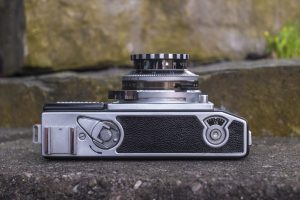
I usually start this section of the review going over the camera’s controls, starting with the top plate, except with the Voskhod, it is not immediately obvious which way is up. The shape and orientation of the viewfinder, plus the location of the shutter release suggest the camera was designed to be used vertically, like the Agat 18K or Taron Chic, but this being a full frame camera, if you want to shoot images in a landscape orientation, you need to hold the camera with the viewfinder in the upper left corner of the back.
This makes the “top” of the camera the side with the accessory show, folding rewind handle, and non-automatic resetting exposure counter.
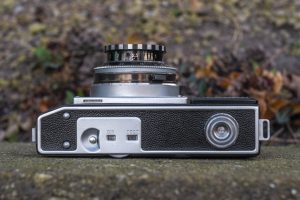
Flip the camera over to the “not top” side, and there is the rewind release, a film speed reminder dial, and like most 1960s Soviet cameras, a 3/8″ tripod socket. If you wanted to mount this to a modern tripod, you’d need a 3/8″ to 1/4″ adapter.
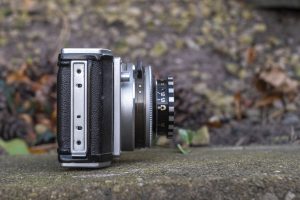
Going with what we’ve agreed upon is the “top” of the camera, the “right” side has the film door release latch, which on this example, is missing a thin piece of body covering which should be on it. From this angle, you can also see the side of the front plate mounted shutter release button.

Finally, the camera’s “left” side simply has the door hinge, but if you look has two strap eyelets, which if you had connected a neck strap to the Voskhod would have supported only this side of the camera, making it appear to be the top.
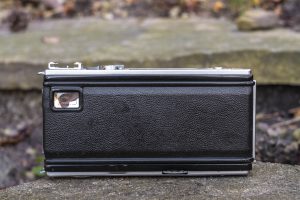
From behind, all we see is the eyepiece for the viewfinder in the extreme upper left corner of the door. Notice that the viewfinder goes through the door, so when it opens, the rear opening of the viewfinder comes with it.
Near the very bottom of the back is the side of the knurled ring which changes the numbers on the film speed reminder dial on the bottom of the camera.
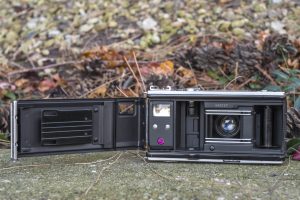
Opening the “left” hinged door, reveals a somewhat normal film compartment. I say “somewhat” as normally you wouldn’t be able to see through the viewfinder from a film compartment, nor would you see the strange purple adjustment knob for the camera’s built in selenium meter, which on this example, did not work.
Film transport is from left to right onto a fixed and single slotted take up spool. The film compartment is nicely appointed with dual film rails and a large, ribbed film pressure plate. The door channel lacks any sort of light seals, but the door hinge side on this one was a thin piece of black velvet, which I would later discover was leaking light, so had this been a camera in my permanent collection, I would have had to replace.
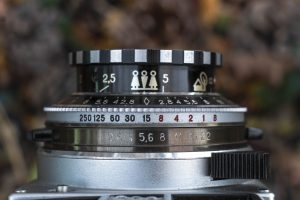
Like most leaf shutter cameras, shutter speeds, aperture settings, and focus are all controlled on the shutter itself, but as I keep alluding to, the correct orientation of the camera’s top is further blurred with the fact that markings for all three can only been seen from the side of the camera with the strap lugs on it. If you were holding the camera in a landscape orientation and then wanted to change shutter speeds, f/stops, or refocus the lens, you’d need to rotate the camera and look at it from this side, rather than the top, like in most other leaf shutter cameras.
The shutter speed and aperture rings on the Voskhod are coupled together similar to how German and Japanese cameras with LV or EV scales are in which rotating one, moves the other. Except in this case, there is no LVS, and both rings rotate in the same direction. Notice the aperture scale goes left to right largest aperture to smallest aperture, and the shutter speeds go right to left slow speeds to fast speeds. This means if the camera is set to 1/15 and f/5.6 like in the previous image, rotating it one click to the left moves it to 1/30 and f/4, and one click to the right to 1/8 and f/8. Each of these combinations make the same exposure.
In order to override this linkage and choose shutter speeds and f/stops independently, you must use one of the two black levers on the aperture ring to rotate it separately from the shutter speed ring. It’s not as frustrating as other LVS cameras I’ve reviewed, but still slows you down. Somehow, I am less annoyed by this system on a semi-automatic Soviet camera as this would have still be cutting edge stuff for a camera made at this time.
One last thing you’ll notice from this angle, is nearest to the body is a lever with a large black handle that resembles a shark’s fin. This is the film advance lever, which also cocks the shutter as you advance the film. When holding the camera with the shutter speed markings facing up, the film advance is activated by pressing down on it, but when holding the camera in a landscape orientation, it operates left to right.

Finally, looking at the front of the camera with it sitting on a flat surface like in the image to the right, the cable threaded shutter release is near the 10 o’clock position around the lens, a film type (separate from film speed) reminder near the 8 o’clock position around the lens, and a flash sync port near the 4 o’clock position around the lens.
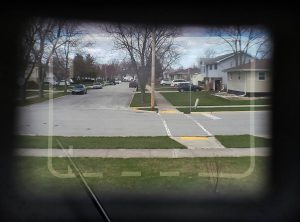
Looking through the large and bright viewfinder is quite pleasant. The lack of a rangefinder means there is no beamsplitter to darken the image, and with projected frame lines matching the 45mm focal length of the lens, a good amount of visual information is there outside the lines. Parallax correction marks are also visible, as well.
Although it didn’t work on this camera, at the bottom of the viewfinder is a large needle for the exposure meter. Under normal operation, the needle would move from left to right, resting between notches in the bottom frame line. If the needle is pointing anywhere between the middle notch, you’d have proper exposure, and in either the left or right notches, would be under or over exposure.
The Voskhod is a strange camera for sure, but that doesn’t make it bad. In fact, I think many of it’s idiosyncrasies make it more appealing. The viewfinder is large and bright, in portrait mode, the camera is very comfortable lens, it’s got a good lens, and when found in working order, has a coupled exposure meter for getting the right exposure. Sure, this all sounds good, but what is it like to actually use?
My Results
Upon receiving the Voskhod, I put the camera through it’s paces and although the meter was completely dead, the rest of the camera seemed to work fine. The shutter fired at all speeds and all of the camera’s other controls all seemed to work correctly, so I loaded in some bulk Kodak TMax 100 and took it with me on a short trip up to Mackinac Island, Michigan.
Well, that’s not good.
From that first roll of film, every single image turned out badly out of focus. Did the Voskhod have a collapsible lens that I wasn’t aware of? Did I have it set to meters instead of feet? I’m certainly not immune to screwing up focus, but I’m not that bad, so what happened?!
As it turns out, some previous owner of this camera had fiddled with it and removed the front lens grouping and whenever they reattached it, they stripped one of the grub screws holding the front lens grouping on and it was not installed correctly, so although I set the lens distance correctly, the scale was not in the correct position on the lens.
A quick lens collimation later, and I had the camera correctly at infinity, ready for another roll of TMax. I wasn’t going to be back up to Michigan for a while, so instead I took it to a local US Veteran’s Memorial park near my house.
I am continually impressed with the quality of Soviet triplets. The T-48 lens, like those found on the Smena-8 and Lubitel delivers above average results. Center sharpness is very good, with minimal softness near the edges. The Voskhod’s shutter, although limited to no higher than 1/250, worked fine shooting outdoors with 100-200 speed film. This isn’t a camera you’d want to shoot ultra fast film for maximum bokeh, but for general purpose photography, it does a very good job.

I genuinely liked the viewfinder, both in portrait and landscape orientation, but I found it to be easier to use in portrait. It’s location in the extreme upper left corner when holding it for landscape, was a bit awkward, especially with the far right location of the shutter release up front.
Although the light meter on this example was not working, the large and easy to see match needle would have been very easy to use on a working copy, making exposure calculation a snap.
Finally, the location and operation of the film advance shark fin worked really well and became one of my favorite things about the camera’s operation. It’s motion was smooth and easy to use, despite it’s unorthodox design.
If it’s not already obvious from looking at it, the Voskhod is an interesting camera. While I can see some benefit in designing a camera that takes into account both portrait and landscape orientation, the camera is more comfortable to hold in portrait orientation. If it’s creators truly wanted a camera that was equally easy to use both ways, they might have considered a different location for the shutter release, or perhaps even a second release. Also, changing the focus scale and shutter speed markings to be readable with the camera rotated 90 degrees would have been a good idea too.

While the T-48 lens certainly does a good job for such a simple 3-element design, and the shutter’s range of 1 – 1/250 seconds is good enough for most general purpose photography, I find it odd that so much thought was put into such a unique camera, giving it a high quality all aluminum body and a large and easy to use selenium exposure meter, while using what looks to be a Smena parts bin lens. Certainly, there were better options available, such as a 4-element Industar or 6-element Jupiter that could have been permanently mounted. With less than 60,000 Voskhod’s made, it’s not like they needed a lens with a huge production capacity.
I can’t help but feel like the Voskhod was a missed opportunity. It almost feels like there was a really good idea there, that whoever was in charge of it’s design, simply couldn’t finish. Perhaps a lack of vision, or more likely, a lack of support by those in charge probably doomed what could have been a really cool camera, into what we have here, a short lived strange looking camera, with questionable ergonomics, and a parts bin lens.
Related Posts You Might Enjoy
External Links
https://camerapedia.fandom.com/wiki/Voskhod
http://www.sovietcams.com/indexb0a1.html
https://kosmofoto.com/2021/05/lomo-voskhod-review/
http://cameras.alfredklomp.com/voskhod/
https://fotoussr.ru/cameras/voshod/ (in Russian)
http://www.photohistory.ru/1207248177771634.html (in Russian)
https://vintagecameralab.com/gomz-lomo-voskhod/
https://sovietcameras.org/voskhod/
https://thefilmrenaissance.wordpress.com/2016/01/01/never-seen-a-voskhod/


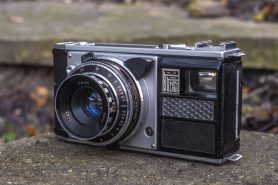
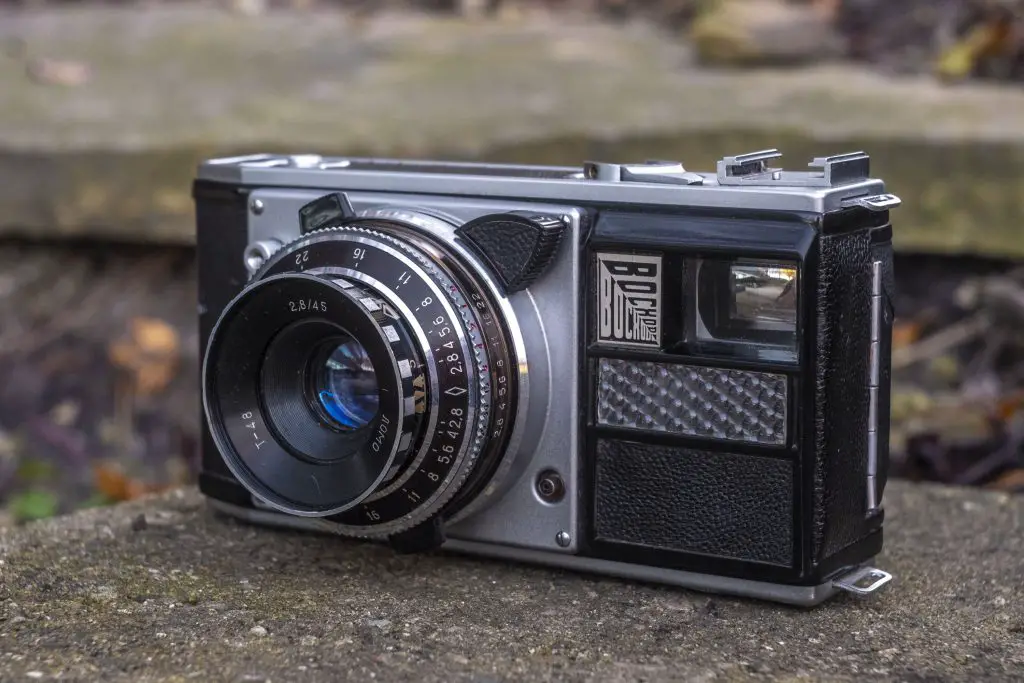
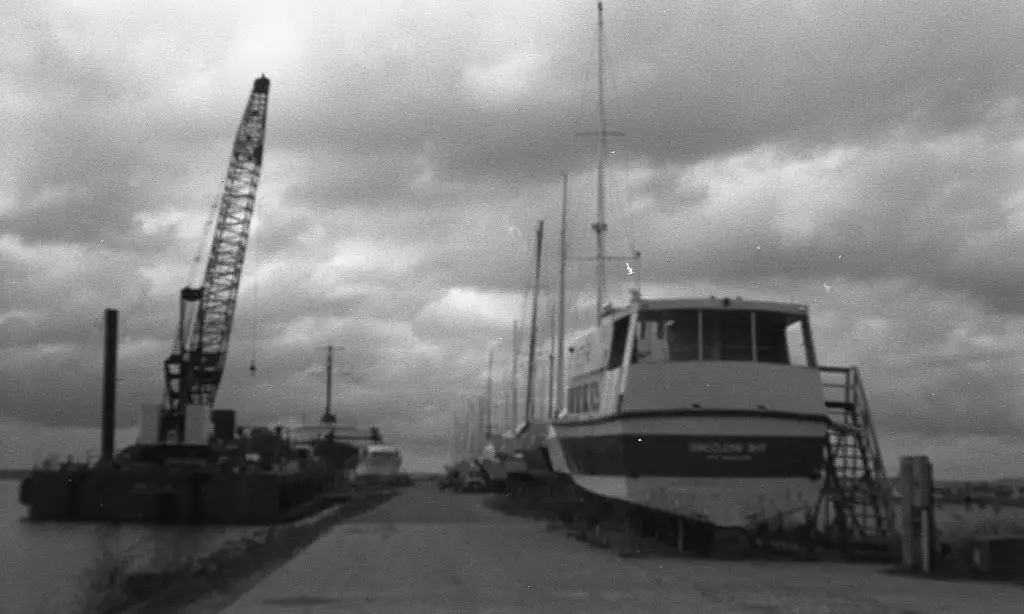
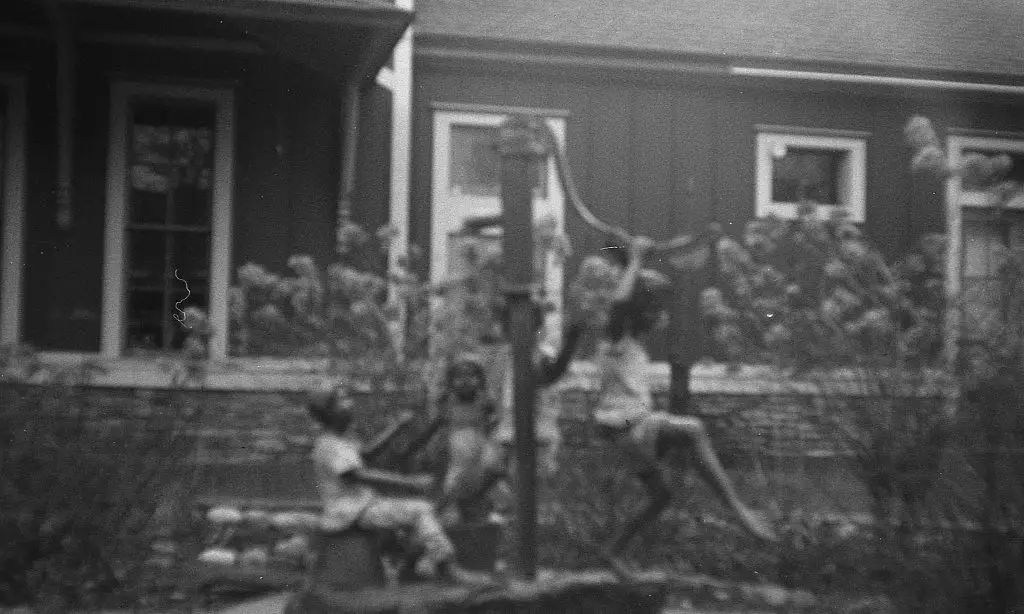
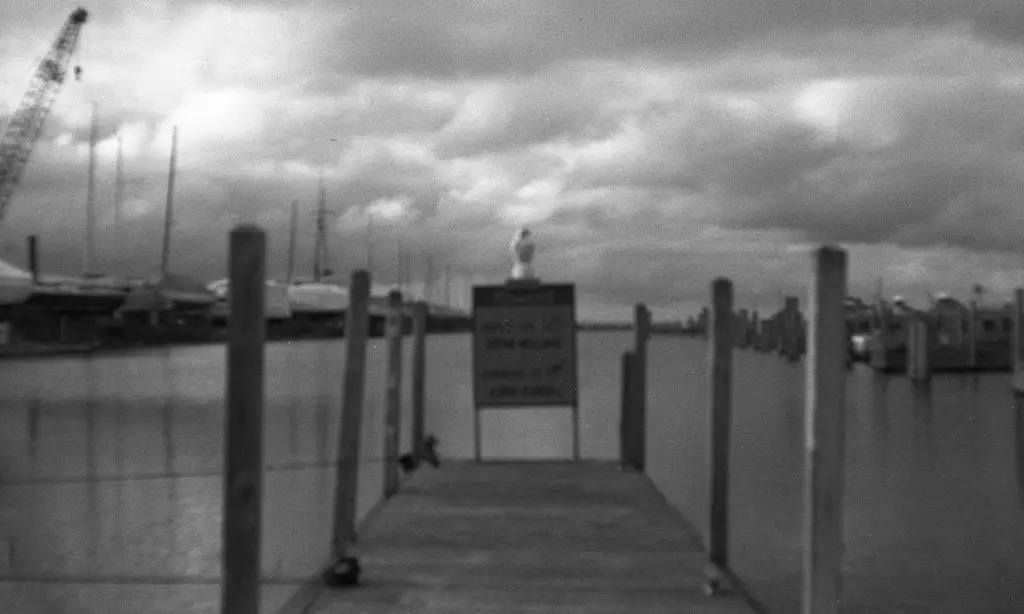












Thanks again for a great review. I have one with a functioning meter (as of 9am Oct.4 2021)-that took me a very long time and some pointed questions)to find. Many sellers did not feel the need to include the meter when describing their cameras as ‘working perfectly’!
The meters on these seem to have an unusually high rate of failure. I’ve never seen one with it working, so yours is definitely something special! Hopefully you get a chance to shoot it at least once to see the results from that lens.
An interesting camera, Mike, with perhaps just a little nod to the designers of the Kodak 500 and Braun 126 cameras. The big advantage today, though, is this one uses 35mm film. The lens certainly seems up to the best of the Soviet triplet designs, and it certainly benefits by your using b/w film so we can better judge the lens’ resolution. For a triplet, I’m guessing that these results are probably some of, if not the best, you’ve achieved with a 35mm film camera.
I can’t say the results from the Voskhod’s triplet are better than those of other triplets, but they’re definitely on par with Zeiss Triotars, Schneider Radionars, Kodak Anastons and other quality 3 element lenses made throughout the 20th century.
Great review of a cool camera, Mike. I’ve got one along with a few more Soviet cameras and was think of shooting a roll for Red Oktober. After reading your review, I am now really motivated to shoot it again. I’ve had good results all along with mine so all is working well, except the meter. I usually use sunny 16 anyway with my phone back-up meter.
Smart move. Even when I get a camera with a meter that responds to light, I almost never use them, instead relying on Sunny 16 or an external meter like you mentioned! They’re fun cameras to use with or without the meter!
Shucks, Mike … Another case of GAS just launched by this detailed review of a triplet-equipped camera.
Glad I could help! This is a really terrific camera that as you can see from my sample images, delivers very good looking photos! I can’t wait to hear your hands on thoughts about it.